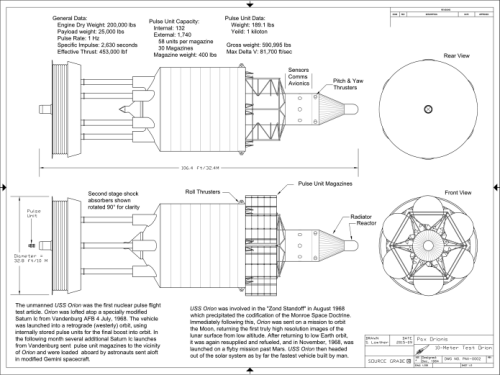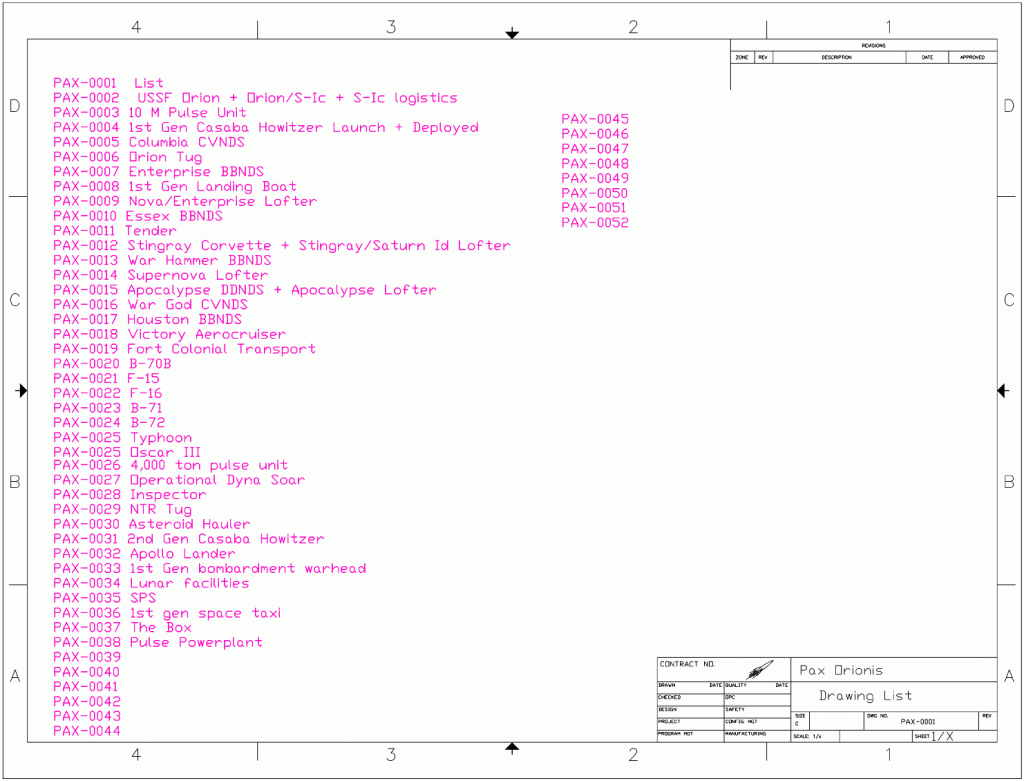Someone took a number of NASA still photos from the Apollo program and animated them, creating a short movie. It’s not one hundred percent effective… no matter what tricks you play, a still photo of a human is going to remain unconvincing as “video,” since humans are always in some form of chaotic motion. But on the whole it’s interesting.
Those of you old enough… remember when parents just *had* to procure a Cabbage Patch Doll, or a Furby, or a Tickle Me Elmo? Well, just in time for Christmas 2015, Raytheon presents the “Pike.”
Miniaturized, Laser-Guided Munition
Pike™ is a 17-inch-long, semi-active laser-guided precision weapon, measuring 40 mm in diameter and weighing two pounds. It’s the world’s only hand-launched precision-guided munition. Fired from a rifle-mounted grenade launcher, the miniaturized munition can travel one and a half miles and hit within five yards or less of a target, minimizing collateral damage.

The laser-guided munition is nearly as narrow as some large-caliber ammunition and can fit in the palm of a hand. A lightweight precision weapon, the Pike munition doesn’t tether ground troops to a vehicle launcher. Using a laser designator that resembles a pistol, one soldier points at a target, while another fires the munition.
Powered by a rocket motor, the Pike munition can be fired from the new family of Enhanced Grenade Launcher Modules (EGLM), specifically the H&K M320 and the FNH Mk13. The munition travels to its target using a high-tech guidance system that brings the same pinpoint accuracy once found only in mammoth missiles and hulking bombs.
The Pike munition can be mounted on multiple platforms, including Class 1 and II, unmanned aircraft systems, all-terrain vehicles, ground mobility vehicles, Common Remotely-Operated Weapons Station and small boats.
I know *I* want a twelve pack.

A mile and a half is pretty good range, but the within-five-yards-of-the-target accuracy seems like it could be better. The size of the warhead doesn’t seem to be given, but it looks like it can’t be much bigger than that of a standard 40mm grenade. I wonder if it would have the ability to nail something like an attack chopper.
It also seems like it might be possible to make a variant that trades the solid rocket motor with more explosive, or even just dead weight. Dropped from an aircraft (a drone, say), if the system is accurate enough it could be used to bullseye womprats from your T-16 take out individual targets with either minimal or maximal collateral damage.
Quick review: a damn fine flick. Sticks remarkably close to the book; the changes aren’t the usual sort of dreck that changes the meaning of the story, or adds needless characters, or any of that. The visual effects are largely flawless (though the gravity centrifuge was apparently static, unlike the USS Discovery’s centrifuge, with the result that in some scenes it’s pretty obvious that actors are walking “down” the floor). The science is pretty good, the acting is good, the dialog works. There are no villains; the drama comes from the situation, not mustache-twirling badguys or steaming morons.
…
Just a few minor things (conversion to PDF & EPUB, uploading, stuff like that) and the second Pax Orionis installment will be posted. This will be “The Deadliest Catch, Part Two,” the conclusion to that particular tale. The bonus will include diagrams and data on the first generation Casaba Howitzer weapon (which has evolved substantially from when i first illustrated it for the pages of APR issue V2N2, years ago), derived from the Orion pulse unit, and a short media piece that fits in with the one included last time. I plan on posting this tomorrow (Saturday).
Patrons who are signed up *before* the story is released will automatically get the story as soon as it’s published. If you sign up *after* the story is published, you won’t automatically get it… but you won’t be charged for it, either. However, patrons may purchase “back issues” for the same price, so you can catch up without any trouble. Each tale is only a buck; with the bonus diagrams and technical discussion, only one additional buck.
If interested, check out the Pax Orionis Patron.
Feel free to tell anyone you think might be interested.
Color me stunned:
Orion astronaut flight faces delay to 2023
Orion, NASA’s modernized Apollo capsule, is looking at a two-year delay until a manned flight. This is due to developmental issues, which can also probably be linked to funding shortfalls. Which might seem a bit odd considering that the amount spent on Orion so far is several *billion* dollars, while SpaceX’s Dragon capsule has only seen a tiny fraction of that amount. Yes, yes, Orion is meant to be capable of a more energetic entry than Dragon, but still…
The first Pax Orionis yarn was posted for patrons at the PS Patreon just a few days ago. Several people signed up afterwards, which meant that they got left out of the first issue. It’s perhaps something of a flaw or shortfall in the system. But I’ve worked out a simple solution: back issues. If you sign up for the Pax Orionis Patreon campaign, you can now purchase each “back issue.” Two dollars per issue is the current goign rate on the Patreon that nets you the story, the Technical Diagram and another bonus feature; that same price will get you those things in the back issue.
Currently there is only the one back issue available. But if you sign up for the Patreon campaign, you can read everything, right from the start. The stories are available as both PDF and EPUB (you get both versions).
The first story released was “The Deadliest Catch, Part One,” and the first technical diagram is of the USS Orion, the first nuclear pulse flight test article in the Pax Orionis world.
—————-
On other Pax Orionis matters, here is the current listing of foreseen technical diagrams:
And here is the current list of chapter titles, in rough chronological (story timeline order:
“The Box”
“Magicians”
“Orion Rises”
“The Blast from Jackass Flats”
“Weapons Test”
“Weapons Test 2”
“Mission to Mars”
“Knock knock”
“Uranium Exploration for Fun and Profit”
“The Burning Desert”
“Down in the Weeds”
“Deadliest Catch”
“Windows over the War”
“Hyperbolic Excess”
“The Hole”
“The Blue Dot”
“Things Blow Up”
“Leviathan”
“Every Man a King, Every Cabin Steerage”
“Sailing the Rocks”
“Over the Ice”
“Into the Deep”
The train of “OMG, the former Soviet space program looks like a zombie movie set” continues with these photos of a wooden Buran mockup. A 1/3 scale wind tunnel model, it has been left out in the elements for several decades. The elements… have not been kind.
Wooden Shuttle: Rotting Wind Tunnel Model from the Abandoned Buran Space Programme

Now available… two new additions to the US Aerospace Projects series.
US Bomber Projects #16: The B-52 Evolution Special
Boeing Model 444 A: A late war turboprop heavy bomber
Boeing Model 461: An early postwar turboprop heavy bomber
Boeing Model 462: A large six-turboprop ancestor of the B-52
Boeing Model 462-5: A six-turboprop B-52 ancestor
Boeing Model 464-17: 1946 four-turboprop strategic bomber, a step toward the B-52
Boeing Model 464-18: a reduced-size version of the 464-17 turboprop strategic bomber
Boeing Model 464-25: a modification of the 464-17 turboprop bomber with slightly swept wings, among other changes
Boeing Model 464-27: a slightly-swept turboprop B-52 progenitor
Boeing Model 464-33-0: A turboprop B-52 predecessor
Boeing Model 464-34-3: A turboprop B-52 predecessor
Boeing Model 464-40: The first all-jet-powered design in the quest for the B-52
Boeing Model 464-40: The first all-jet-powered design in the quest for the B-52
Boeing Model 464-046: A six-engined B-52 predecessor
Boeing Model 464-49: The penultimate major design in the development of the B-52
Fairchild M-121:A highly unconventional canard-biplane
Convair B-60: A swept-wing turboprop-powered derivative of the B-36
Douglas Model 1211-J: An elegant turboprop alternative to the B-52
With additional diagrams of the B-47, XB-52 and B-52B
USBP#16 can be purchased for downloading for the low, low price of $6.
—
US Spacecraft Projects #03
Northrop ST-38 Space Trainer: a rocket-powered T-38 for trips to space
“Have Sting:” A General Electric design for a gigantic orbital railgun
JPL Thousand Astronomical Unit probe: A spacecraft into interstellar space
Integrated Manned Interplanetary Spacecraft: A Boeing concept for a giant spacecraft to Mars and Venus
Convair Inflatable Spacecraft: an early spaceplane concept
One Man Space Station: A 1960 McDonnell concept for a tiny space station
Astroplane: A lightweight aircraft for the exploration of Mars
Reactor-In-Flight Test: A Lockheed nuclear-powered stage for the Saturn V
USSP#03 can be purchased for downloading for the low, low price of $5.
—
The first story is now available for Pax Orionis patrons. This is available for the low, low price of only a buck. But if you pledge $2 or more, you get not only the story – “The Deadliest Catch, Part One” – but also a Technical Diagram and description of the USS Orion test flight article, and a bonus news article, the first of a number that will tell a tale.
Boeing has released some pretty animation of their Commercial Space Transport space capsule. Together with Dragon and Orion, the US *should* be back to sending its own astronauts into space in a few years.
“Starliner” is of course not an entirely accurate name. It’s not going to the stars, only low Earth orbit. And it carries a total of four passengers… not much of a liner.
Pfff. Inaccurately named vehicles? Perish the thought.






